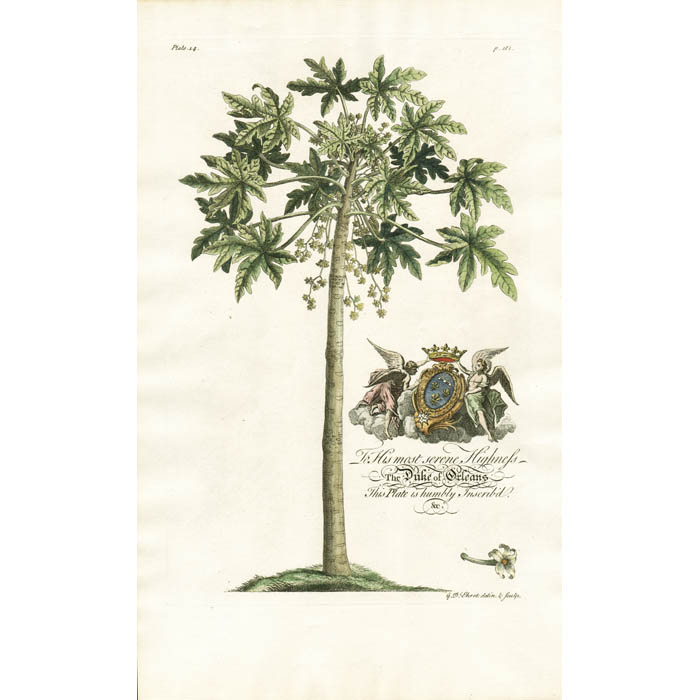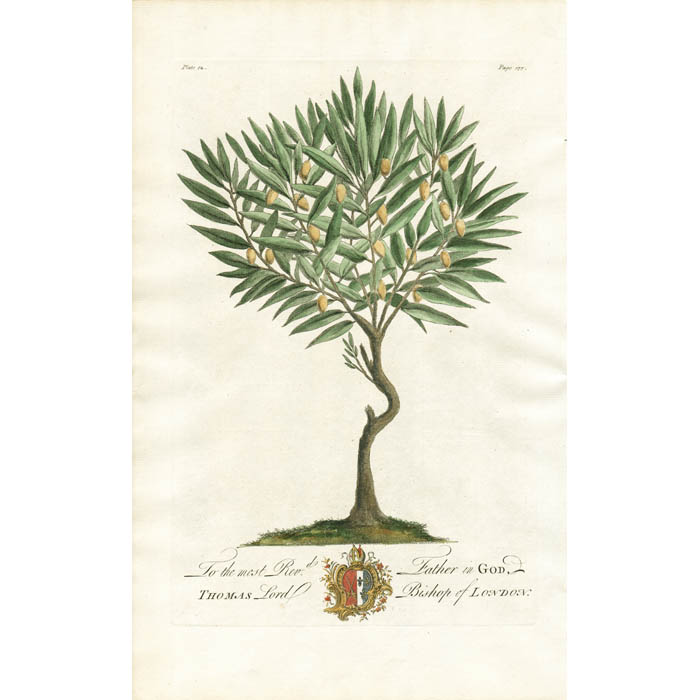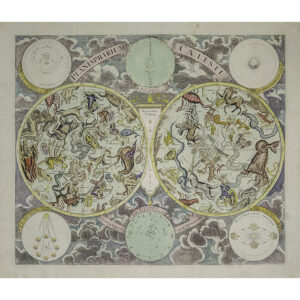Description
Georg Dionysus (G.D.) Ehret was the dominant influence in botanical art during the 18th century. Ehret was born in Heidelberg, Germany, and trained as a gardener. He became the protégé of the Margrave of Baden-Durlach, who hired him to design town and palace gardens at Karlsruhe and make paintings of his flowers. After leaving the Margrave’s employ, relocated in Regensburg, where he met Johann Wilhelm Weinmann, and was engaged to produced drawings which were to be his first published works, for Phythanoza Iconographia. Upon producing the first 500 drawings, he had a dispute with Weinmann over compensation and obtained a new position copying plates for another patron, while also working independently on new paintings. His talents were recognized by Dr. Jakob Trew of Nuremberg, who became his lifelong patron and friend. With Trew’s backing, Ehret was able to leave his copying job. He traveled through Europe, including to Leiden in 1736, where he met the eminent naturalist Linnaeus, and then settled in England, where he remained the rest of his life. In London, he had a busy and successful career as a painter and instructor, obtaining numerous commissions from aristocratic patrons and having several duchesses and countesses among his pupils. Over his career, Ehret produced an important body of botanical paintings, including plates for a number of florilegia and travel books, notably Trew’s Plantae Selectae (1750-1773) and Hortus…Amoenissimorum Florum (1750-1786), and his own Plantae Paliliones Rariores (1748-1759) and Natural History of Barbados (1750). He often engraved his own plates. In 1757, he was made a Fellow of the Royal Society. His works today are represented in many important museum collections including the Victoria and Albert Museum and the British Natural History Museum.
Griffith Hughes was a cleric and naturalist, thought to have been born in England. He was educated at Oxford in 1729 and ordained an Anglican deacon and priest in 1732, and thereupon sent to Pennsylvania to work as a missionary among the Welsh Quakers. Due to health problems, in 1736 he was transferred to St. Lucy’s Parish in Barbados. In 1748 he returned to England and finished his bachelor’s and master’s degrees, and was elected a Fellow of the Royal Society. In 1750 he produced The Natural History of Barbados, which is notable in part for containing the first scientific report of the existence of the grapefruit, a natural hybrid that appeared on Barbados, which Griffith referred to as “the forbidden fruit.” (That print, titled “Forbidden-Fruit-Tree,” is among those offered here. Click on the main image and scroll through the images using the arrow keys.) The work was praised by the eminent biologist Linnaeus. Apparently Hughes did not return to the ministry afterwards.
James Mynde was a British engraver, working in London on a range of subjects including portraits, landscape and natural history plates, and also engraved the gores for some of James Ferguson’s globes. He is noted for his anatomical plates and portraits.
Condition: Generally very good with the usual light overall toning and wear.
References:
Bénézit, E. Dictionnaire critique et documentaire des Peintres, Sculpteurs, Dessinateurs et Graveurs. France: Librairie Gründ, 1966. Vol. 6, p. 292.
Blunt, Wilfred, rev. by Stearn, William T. The Art of Botanical Illustration. Woodbridge, Suffolk, England: Antique Collectors Club, 1994. pp. 25, 155, 159-166.
Hughes, Griffith. The Natural History of Barbados. London: 1750. Online at New York Botanical Garden Mertz Digital Collections: http://mertzdigital.nybg.org/cdm/ref/collection/p9016coll23/id/21115 (8 March 2018).
Jenkins, Robert Thomas. “Hughes, Griffith.” Welsh Biography Online. 2009. http://yba.llgc.org.uk/en/s-HUGH-GRI-1707.html (23 February 2011).




![The Pine Apple; Lat. Anana [Pineapple]. Plate 21. Page 231. The Pine Apple; Lat. Anana [Pineapple]. Plate 21. Page 231.](https://www.georgeglazer.com/wpmain/wp-content/uploads/2017/03/hughes-barbados-plate21.jpg)








![The Sea-Side Laurel [Seaside Laurel]. Plate 22. Page 233. The Sea-Side Laurel [Seaside Laurel]. Plate 22. Page 233.](https://www.georgeglazer.com/wpmain/wp-content/uploads/2017/03/hughes-barbados-plate22.jpg)
![The Sugar-Cane; Lat. Arundo Saccharifera, fig. 1. The Indian Corn; Lat. Mays, fig. 2. Guiney Corn; Lat. Milium Indicum arundinaceum, fig. 3 [Sugar Cane, Indian Corn, and Guinea Corn], Plate 23 The Sugar-Cane; Lat. Arundo Saccharifera, fig. 1. The Indian Corn; Lat. Mays, fig. 2. Guiney Corn; Lat. Milium Indicum arundinaceum, fig. 3 [Sugar Cane, Indian Corn, and Guinea Corn], Plate 23](https://www.georgeglazer.com/wpmain/wp-content/uploads/2017/03/hughes-barbados-plate23.jpg)







